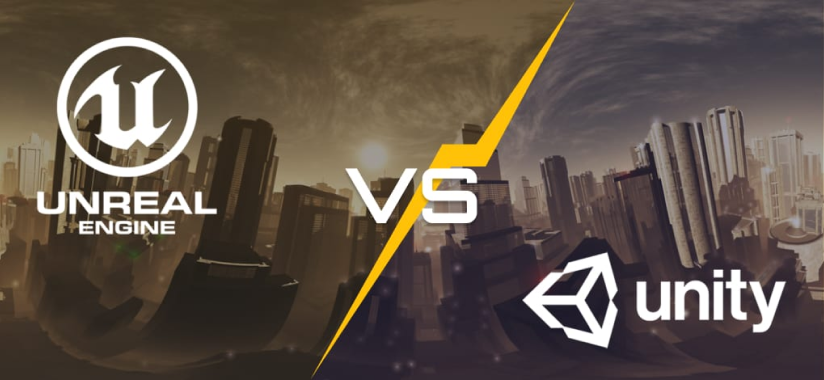VR game development is rapidly becoming a popular investment. The number of VR headsets sold worldwide during the last 2 years exceeds 10 million. VR games running on those headsets generate millions of dollars in revenue annually. The VR applications market is currently valued at $15 billion. It is expected to enjoy multi-fold growth by 2021. And it is games taking the biggest share of this market!
Sounds like another big winner, doesn`t it?
Major companies, like Facebook, Google and Microsoft, are joining the VR industry. Sony, Samsung, Apple and HTC are conceptually designing new VR devices to make VR hardware more affordable for the mass-consumer market. Now we can choose from a wide range of VR equipment— from light and inexpensive mobile VR gear to heavy and expensive VR consoles. In this range, each hardware solution assumes its own level of equipment complexity and cost. The same goes for games running on that equipment. In a later article, we will review the possible costs of VR game development in detail.
In this article, read which steps each VR game producer must take to develop a VR game and publish it in Steam, Viveport, Weavr, Oculus, Google Play, Apple APP or any other app store.

When planning your VR game development , consider these 7 steps as a roadmap for you :
1
You must find (or generate) a fresh game idea
You must find (or generate) a fresh game idea.
You must find answers to these—and similar—questions:
- Who is your target audience player?
- What WOW moments does your game have?
- What emotions does your game trigger?
- Why should your game use VR?
At this stage, prepare a game scenario you can share with your developer. Also, either you or a hired game producer (or in collaboration) should work on the game design document with user stories. This work is normally included in VR game cost.

2
Choose the target VR devices for your game
Basically, you can choose from the following five solutions:

Light Mobile VR like Google Cardboard and similar solutions
Google Cardboard often looks like a simple headset with two lenses and fasteners holding a smartphone. However, Google sets definite requirements for the headset, smartphone, and third-party software so that their combination may be called “Google Cardboard”. Light Mobile is a good choice if your game does not require motion sensors and head movements. It is the least expensive VR headset you can find—$10 special offer on the official Google store. A free VR Software Kit (for mobile technology) works in this case.
Premium Mobile VR (Gear VR, Daydream, etc.)
Premium mobile VR devices (Daydream and Samsung VR) are also using smartphones to engage users into a VR world. However, those devices have additional set of sensors (in particular, for head movements) enriching user experience comparably with less complicated viewers. The price for a new Daydream VR set starts at $83 on Ebay.com.
PC VR-headsets (Oculus Rift, HTC Vive, Windows Mixed Reality, etc.)
PC-based VR-headsets make it possible to immerge more deeply into Virtual Reality by means of larger PC screens and more powerful PC processors. For those viewers, it is possible to develop more complicated applications. The price for new PC VR-headsets varies from $499 for Windows Mixed Reality at Windows store, $529.99 for HTC Vive on Ebay.com and $800 on Amazon.com.
Standalone solutions (Oculus Go, Oculus Quest)
Oculus Go headset does not require a PC or an external play station to work, it has its own embedded processor and memory. Oculus also has its own software platform for VR games development that also supports Unity and Unreal game engines. The cost for such devices starts at $199 for Oculus Go on Amazon and $399 for Oculus Quest also on Amazon.
Console VR (Sony PlayStation VR)
PlayStation VR is a VR headset designed to work in conjunction with PlayStation 4, PlayStation Eye camera and DualShock and Move controllers. It should also work with PlayStation 5 (coming soon, as the producer promises). Sony suggests a partnership program and special licensing covering all the legal aspects of their VR games development for those who would like to develop applications for their PlayStation. The cost for the official Sony PlayStation VR bundles starts at $250.80 on Amazon, but you will also need Sony PlayStation 4 hardware to connect to it. PlayStation 4 console can be purchased for $281.95 on Amazon.
NOT SURE ABOUT APP REQUIREMENTS? WANT A FREE COST ESTIMATE?
Contact us. Tell your idea. We can help.
Contact us
3
Choose the type of graphics for your VR game in development
A Virtual Reality game development cost depends significantly on the game’s design. Each type of design mentioned below has its own advantages. You can start creating VR content on your own or ask professionals for help. An expert consultant assists in choosing the type of graphics that would work best for your game purposes. The four types of design include:

2D graphics
Though 3D is available already, 2D design still claims top position for virtual games. It can look very professional, detailed and complex, and be on a par with 3D. The cost for 2D-game-design development could be low if you choose DIY editors or quite high if you decide to hire professionals and create something elaborate.
3D graphics
Sometimes 3D graphics could be easier to create than 2D depending on the game parameters. In addition, 3D looks completely different! Game engines like Unity or Unreal engine are the most popular and comfortable tools for 3D-VR-game development.
Photorealistic graphics
Photorealistic graphics, especially the one imitating nature, normally requires significant investment of time and budget.
360 panoramic video
It is already possible to add 360-degree-panoramic view as the backend for VR games. Cost for a 360-video shot is not expensive but adding interactive elements to the video presents a challenge!
4
Choose the development platform for your game

Your next decision: choose the VR game development software. Though there is a definite diversity of software tools on the market, the serious choice lies between two proven VR game engines: Unity and Unreal.
Our development team leans toward the Unity engine for the following reasons:
- Unity supports both 2D and 3D graphics.
- Unity supports such popular programming languages as C#, UnityScript, and Boo.
- Unity supports of ALL mobile, desk, web and console platforms.
- Free Unity version supports Mac OS X, Android, iOS, Windows.
- Paid Pro version supports Nintendo Wii, Xbox 360 and even Sony PlayStation;
- Unity has the longest track record of games developed for mobile platforms.
- Unity was used to develop Call of Duty, one of the most complex and popular games for now.
- Unity enjoys a vast community of developers.
- Unity has plenty of plugins and helpful tools.
- Unity supports a wide range of asset formats.
- Unity creates quite functional games quickly and easily.
Unity does not provide access to its source code. However, any problem can be resolved with the help of its wide and welcoming developers’ community.
Some facts about Unreal Engine VR game development software to consider:
- Well-suited for console-based games.
- Provides an open source code that is comfortable for developers.
- Appropriate for large projects with heavy 3D graphics.
5
Choose the developer and define your VR game cost
Choice of developer for your VR game is a really important step because it completely defines your game implementation success.
VR game development has definite peculiarities and challenges. When a developer already knows them, he can avoid making mistakes in the new game.
An experienced team saves you time and money. They overcome any technical challenges quickly; whereas, a newbie gets tangled up in each and every technical problem.
Lack of experience costs you time: your anticipated timeline slips.
Your planned launch is delayed. What does this mean? It means you lose money twice:
- paying the newbie developer while he is spinning his wheels
- loss in revenue because of launch delay
You do not want that to happen.
At the first glance, rates for an experienced team might seem high compared to a newbie’s rates. But in the end, you get great work for a reasonable price—timelines seldom, if ever, slips because of them. If you chose somebody new in the VR sphere, you might have to suffer through numerous alterations and iterations costing you additional time and money.
The cost for your VR game might vary considerably depending on all the factors listed above in our article, including:
- target hardware
- chosen graphics and development platform
- game scenario and desired functionality
An expert team—like IT Craft–gives you advice on all the relevant factors to help you choose the best possible options for your game. Companies like IT Craft play the long game: they do their best for each of their clients.

6
Game Research and development
Game creation has its own peculiarities. It is good practice to test the game early and often. Start first with a very simple prototype (MVP) to ensure it is super interesting for players. Regular tests after each development iteration also elicit feedback from players—feedback you might consider later, down the development road.
Such a seemingly slow, step-by-step approach gives greater clarity to go in the right direction from the very beginning, by adopting game scenarios based on user feedback during the development. This kind of approach is better than having to rebuild the whole game from the ground up because you failed to show respect to your target market and get feedback from them before completing it.
And they found it lacking and not to their taste.
Yes, a game scenario requires testing, as well as functional implementation. Game technology means developing quickly. Various game platforms and VR hardware exhibit their own challenges and limitations all the time. To accomplish this, developers must keep on top of the latest VR game development innovations when developing a new game.
Another reason why you should choose an experienced software development team: they keep pace with innovations and stay on top of the game.

7
Publishing
Another important step: publish your game in the market where players will be able to find it. Markets normally provide a range of requirements the game must meet to be presented to the public.
You could publish your game yourself. Better yet, choose a third-party service providing guidance in this process (like Things3D, for example).
The main markets for VR games include:

Conclusion – Summary of tips from our experienced VR game development company
Summing up, we can state that creating a VR game is a project not unlike bringing up a baby:). You must prepare yourself to go the long haul with different steps that, at times, might not be easy but could bring you a great reward in the future. The more you invest in your VR game idea and implementation, the greater your chances of bringing a great product to the world.
An additional challenge VR games present is that, besides an original idea for scenario and graphics, you also need a good technical understanding of what is necessary:
- what device will be used for you game play,
- what limitations and possibilities it provides,
- what technical platforms and engines would be suitable for the chosen device constraints.
VR technologies are comparably new and develop quickly. You need input from a technical expert about your game project—unless you are a VR game developer yourself.
IT Craft company is here to be in lock step with you on this challenging journey. We are VR geeks and are always ready to help you from development to launch , keeping the final VR game cost to your budget expectations. After launch? We do not desert you after launch. Ask us about our policy and promise.
Investing in VR games development is a great opportunity to take your share in a quickly developing and promising market. So, hurry up and reserve your portion of reward that is predicted to grow in the nearest years!










